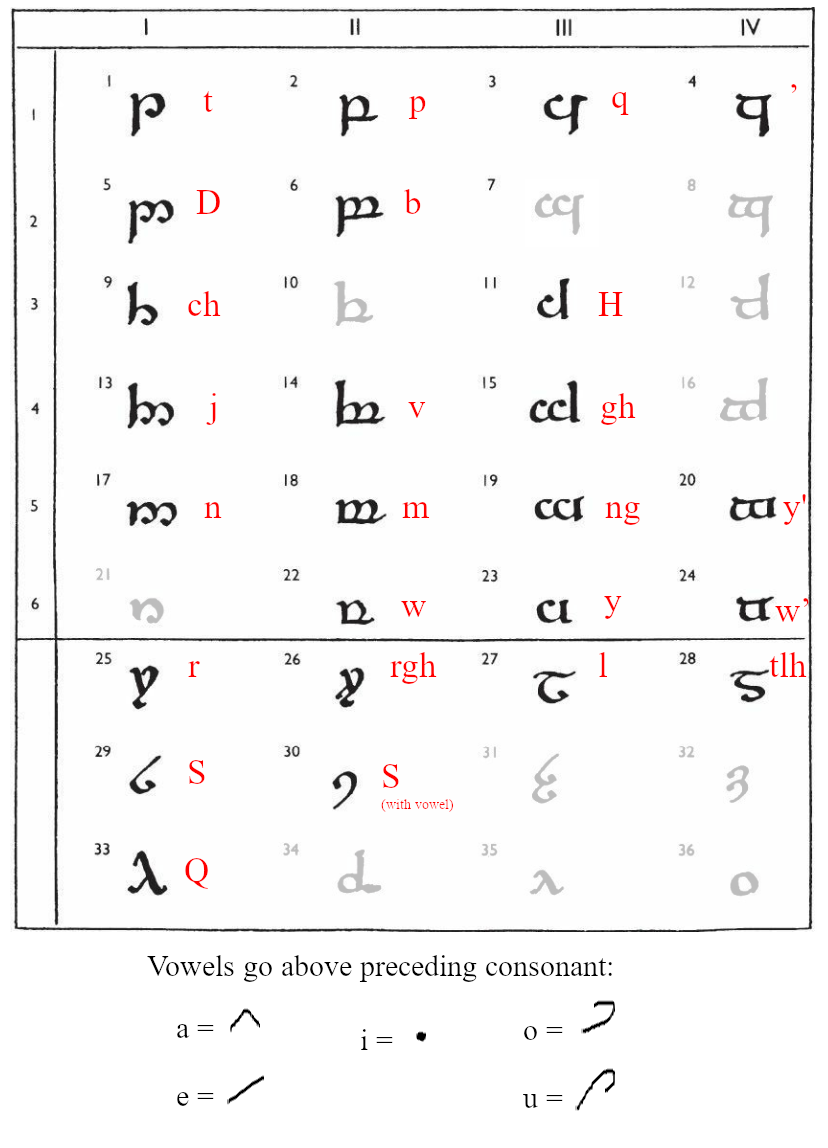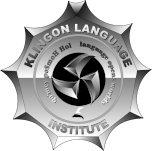Introduction
On the Klingon Language Mailing List, someone asked if anyone had devised a Klingon mode for Tolkien’s Tengwar lettering system. I found one buried in a program on the Internet, but it seemed fairly arbitrarily constructed to me. I took it upon myself to create my own Klingon mode for Tengwar.
Resources you’ll need
This is a pretty esoteric topic. To understand what I’m talking about, you’ll need the following:
- Understanding of the Klingon sound inventory
- Familiarity with Appendix E of The Lord of the Rings, particularly section II
- Some understanding of phonology
- The Return of the King
- HolQeD Vol. 1, No. 1
Klingon phonology and Tengwar

As explained in Appendix E of The Lord of the Rings, the Tengwar are divided into four series and six grades, with additional letters added. Series I was used for the “dental” series in all modes, and Series II the labial series. The application of Series III and IV varied. Grades 1 and 2 were used for unvoiced and voiced stops, Grades 3 and 4 for unvoiced and voiced “spirants” (fricatives and affricates), and Grades 5 and 6 varied, usually for nasals and weak or semi-vocalic consonants.
Because Klingon has such a varied set of articulation points and manners, I wondered how to assign the series and grades for Klingon. I went back to HolQeD Vol. 1, No. 1, to Allan C. Wechsler’s excellent, though very technical, article “First Steps Towards a Phonological Theory of Klingon.” Wechsler examines the consonant system of Klingon and determines that it has 7 or 8 distinctive points of articulation, as well as 11 different manners of speaking at these points, but that most of the possible consonants created by this matrix aren’t used in Klingon. He then postulates a consolidated matrix that might apply to Klingons, given “relatively shallow production rules” (e.g., p and b are bilabials and v is a labial-dental, but he’s going to say that they can all be called “labials” and that they are produced in a similar enough fashion as to be classified together).
This idea reduces the table into one with only four articulation points. That’s the number of Tengwar series! We will accept Wechsler’s hypothesis as correct for the purpose of creating this mode.
We still have too many manners, though. There are unvoiced and voiced stops, unvoiced and voiced fricatives, unvoiced and voiced affricates, nasals, glides, a trill, a lateral, and a lateral affricate. We’re going to need those extra Tengwar letters.
Assigning characters
As per the matrix, Series I will be the “Apical” series, series II will be the “Labial” series, series III will be the “Dorsal” series, and series IV will be the “Glottal” series. Grade 1 will be the unvoiced stops, and Grade 2 the voiced stops. Grades 3 and 4 are problematical; I’ll return to them in a moment. Grades 5 and 6 will be as the common Elvish modes: 5 is for nasals, 6 is for “weak” consonants.
When Tolkien used the term “spirant”, he meant both fricatives and affricates. But we have, for example, two unvoiced dorsal spirants in Klingon, one a fricative (H) and one an affricate (Q). They can’t both use the same letter! Fairly arbitrarily, I’m going to assign Q to letter No. 29: Quenya used No. 11 for the same sound as Klingon H, so I’ll keep No. 11 as H. No. 33 was an alternate for No. 11 (though I’d hardly call it a “weaker” sound, which is what it was usually used for), so Q will go on No. 33. Likewise, we have a conflict with S and ch (both of which want to go on No. 9). Since No. 29 typically represented s, I’ll again arbitrarily put Klingon S there, leaving ch to go on No. 9. That leaves the rest of the “spirants” free and clear. For dealing with vowels (see below), we’ll also want to use No. 30: a variant of No. 29 that is more convenient when using tehtar.
This particular choice is desirable for another reason: H has a voiced counterpart (gh), as does ch (j), but Q and S. don’t. Better to put these down below rather than the others.
So, let’s map those sounds! (The letter x will be used to indicate “letter not used.” There are a lot of Fëanorean letters that won’t be used in this mode.) Refer to the chart above.
| Series I | Series II | Series III | Series IV | |
|---|---|---|---|---|
| Grade 1 | 1=t | 2=p | 3=q | 4=' |
| Grade 2 | 5=D | 6=v | 7=x | 8=x |
| Grade 3 | 9=ch | 10=x | 11=H | 12=x |
| Grade 4 | 13=j | 14=v | 15=gh | 16=x |
| Grade 5 | 17=n | 18=m | 19=ng | 20=x |
Grade 6 represents “weak consonants,” which generally meant l, w,, y, and untrilled r. Klingon has no untrilled r, and no. 27 is said to have been universally used for l, so we’ll put that there, leaving us with w and y. W is a labial consonant, so it belongs in No. 22, and y is palatal, putting it in No. 23.
| Series I | Series II | Series III | Series IV | |
|---|---|---|---|---|
| Grade 6 | 21=x | 22=w | 23=y | 24=x |
Consonant clusters
Klingon has three consonant clusters, w’, y’, and rgh that mess with the otherwise perfect CV[C] syllable structure. Tengwar can accommodate this.
w’ is a “weak consonant” combined with a glottal, which we can represent with Series IV, Grade 6 (No. 24). y’ would also deserve this spot, but putting w’ there blocks it. But y' is a palatal much like the rest of Series 5, so it belongs in No. 20. To reiterate Grades 5 and 6:
| Series I | Series II | Series III | Series IV | |
|---|---|---|---|---|
| Grade 5 | 17=n | 18=m | 19=ng | 20=y’ |
| Grade 6 | 21= | 22=w | 23=y | 24=w’ |
The character for rhg will be dealt with below.
Additional letters
No. 25 was used by the Elves for a trilled r. That’s where we’ll put Klingon r (that’s what it is). I will fairly arbitrarily put the consonant cluster in No. 26, which is just a modified version of 25. We’ve already placed our lateral l on No. 27, so we’ll again fairly arbitrarily place our related lateral affricate tlh on No. 28, which is a modified form of No. 27 anyway. This gives us the following used additional letters:
- 25=r
- 26=rgh
- 27=l
- 28=tlh
- 29=S
- 33=Q
Now for vowels. This part is all pretty arbitrary, but easy. We’ll use the tehtar, rather than full vowel letters, ’cause I like ’em. Tolkien says that in languages where most words end in a vowel, the tehtar would be placed over the preceding consonant. This is not Klingon. In Klingon, most words end in a consonant, like Sindarin. However, the point of this tendency is to put the tehtar over consonants instead of short carriers as much as possible. Klingon words never begin with a vowel, so if we put the tehtar over the preceding vowel, we’ll never use the short carrier at all. The other way, and you will have to use it for those few words that end in vowels, like HaSta. Like I said, fairly arbitrary, though it has a logic of its own. Besides, verb prefixes get a little less mixed up with the rest of the word this way.
More arbitrary choices: a will be represented by a circumflex-like character. Tolkien says this form was often used, and it looks pointier, and thus more Klingon, to my eyes. I is represented by a single dot, and e by an acute accent. For o and u, which one takes the right-curl symbol depends on which one is more common in the language—I don’t have that information, so I’ll mimic the Black Speech (hey, it’s Klingon we’re talking about here!) and have u take the right-curl. o gets the left-curl.
Doubled consonants may be abbreviated by placing a tilde-like bar below the consonant.
Possible alternatives
This system isn’t perfect, due to Klingon’s odd sound inventory. A number of alterations are possible, especially around some of the more arbitrarily chosen parts. There are two in particular that strike me as likely, though I have not incorporated them into the mode.
First, the problem of series IV. It’s only got one letter: '. This might be remedied by using No. 12 for Q. Q isn’t really a voiceless spirant glottal consonant, but it’s close. One might stretch the point to use up more of the main letters.
Secondly, there are two other grades that haven’t been used. These are like grades 3 and 4, except that they have an “extended” stem, raised and lowered at the same time. In Elvish languages, these might have represented aspirated consonants, but Klingon stops are normally aspirated anyway! These two grades were also used for other purposes. They could conceivably be the grades that separate the affricates from the fricatives. I’d probably make the fricates grades 3 and 4, and the affricates the two extra grades (since an affricate is a combination of a stop and a fricative).
Tengwar has several special marks used to abbreviate writing. The doubled-consonant bar is one. Tengwar also allows a downward hook to attach to a consonant to indicate a following s, a bar above consonants to precede them with a nasal (nt, nd, and so on), and other marks. Klingon has a few special consonant clusters at the ends of syllables that could be well-served with abbreviations like these. w', y', and rgh are those clusters. However, Tolkien never suggested any marks that would correspond to these clusters, and I am loathe to hijack other symbols to accommodate them.
Remember, I haven’t incorporated these alternatives into the mode.
Examples
The page of examples shows what Klingon looks like when written in the Klingon mode for Tengwar.
Conclusion
And there it is! SuStel’s Klingon mode for Tengwar. As logical a layout as you can devise.
Comments are welcome. Praising me with great praise is preferred, but I’ll take criticism too.
